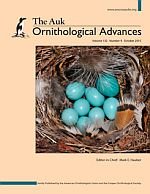Joe Marshall began his international career with his birth in Paris on February 15, 1918. His father was on General Pershing's staff during the First World War. The family returned to the United States in 1919 and settled in California, where Joe attended the University of California (UC) at Berkeley. His diverse zoological career began with a survey of mammals and birds of Redwood Mountain, Tulare County, California (Marshall 1939, 1942). He traveled as a member of the UC Expedition to El Salvador, where he studied the behavior of California's wintering forest birds (Marshall 1943).
During World War II, Joe served as a captain and parasitologist in the Army Medical Corps assigned to Saipan to study and eradicate malarial mosquitos on the island, which had just been wrested from Japanese control. A Marine sergeant, Philip Krutch, charged with securing the island from Japanese snipers hiding in the caves that pocketed the coastal cliffs, ran into Joe hiking along the very same cliffs with a butterfly net, trying to capture Edible-nest Swiftlets that were nesting in the area. This led to a dressing-down of the Army captain by the Marine sergeant. (The incident was relived with great humor when, after the war, both men found themselves attending graduate school at the Museum of Vertebrate Zoology at UC Berkeley.) This encounter underscores Joe's total commitment to biology. War zone? Front line? Danger? Edible-nest Swiftlets nested in these caves, and he had never studied—probably never seen—this species (the source of the nest for bird's nest soup), which might harbor the malarial parasite that the mosquitos were transmitting.
After the war, Joe earned his Ph.D. and accepted a professorship at the University of Arizona. He studied birds and vegetation in the mountains of southeastern Arizona. That led to several publications and to his collaboration on The Birds of Arizona with Allan Phillips and Gale Monson. The book emphasized taxonomy, migration, and the interrelationship between birds and native vegetation.
In 1964, the year the book was released, Joe accepted a job as medical biologist, later zoologist, at the Walter Reed Army Institute of Research in Bangkok, Thailand. While there, he embarked on studies of Asian owls and the distribution of Asian birds in relation to vegetation, and plunged into an extensive study of the phylogeny of mice and rats based on DNA technology, a newly emerging evolutionary tool. His breadth of interests expanded yet again when he began a study of song in gibbons, then added a comparative study of sounds of owls and, later, nocturnal birds. He published his findings in scientific journals and produced recordings of night birds and a recording of all gibbon species.
He returned to the United States in the late 1970s, to a position with the Biological Survey, U.S. Fish and Wildlife Service. Although based at the Smithsonian, he used his age and his early studies to look at changes in bird populations in geographic areas he had studied as an undergraduate (Marshall 1988). With his retirement in 1986, his focus shifted to conservation (Lanning et al. 1990).
An accomplished zoologist with broad interests, Joe published 47 papers on birds, 31 on mammals, and 1 on reptiles. He was well trained in traditional techniques of observation and taxonomy but also learned and used new techniques, including chromosomal analysis (beginning in 1970) and sonographic analysis of vocalizations (1977). Of course, he wrote—and wrote well—but his diverse interests were not limited to zoological taxa only. He was an accomplished watercolorist who illustrated a number of his publications, including cover art (Marshall and Marshall 1976).
Joe was also a skilled musician and a devotee of Johann Sebastian Bach's keyboard music. To recreate the tone of the instrument Bach knew, Joe built a replica of a 17th-century Johannes Ruckers harpsichord. To create the beautiful floral decorations for his replica, he mixed egg tempera from scratch, using pigment and real eggs. One evening, his wife Elsie started painting beautiful flowers on the soundboard, but in the morning they came down to find the paint nibbled away by ants. This was in the tropics, in Bangkok. From then on he added a little arsenic to the formula. Other harpsichords followed, and Joe then set out to play his way through all of Bach's keyboard music. His children recall that he played in a calm and stately manner on his authentic instruments, which had a distinctive and beautiful sound, without the brassiness of modern harpsichords.
On February 22, 2015, Joe Marshall, ornithologist, mammalogist, conservationist, musician, and painter, 20th-century Renaissance man, died peacefully.





